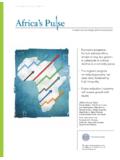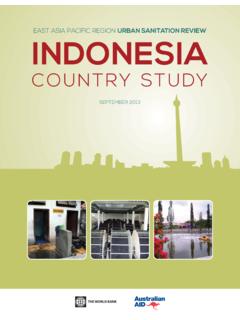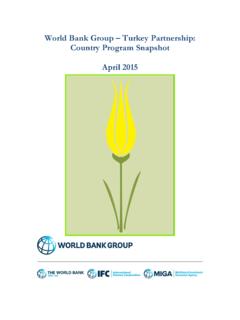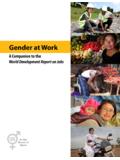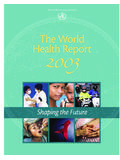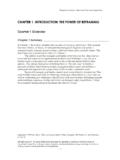Transcription of Toward a Healthy and Harmonious Life in China: …
1 HUMAN DEVELOPMENT UNITEast Asia and Pacific RegionToward a Healthy and Harmonious life in China: Stemming the Rising Tide of Non-Communicable DiseasesToward a Healthy and Harmonious life in China: Stemming the Rising Tide of Non-Communicable Diseases discusses why priority attention to non-communicable diseases (NCDs) is now required in China, articulates what would constitute an effective NCD response, and proposes how to operationalize the response over the medium and longer is expected that the findings and recommendations of this report can inform and promote a broad dialogue Toward the development of a multisectoral response to effectively address the growing burden of NCDs in China.
2 Including a better alignment of the health system with the population s health effective response by China to address the NCD challenge in the years to come could be a powerful example that would significantly influence the rest of the a Healthy and Harmonious life in China: Stemming the Rising Tide of Non-Communicable Diseases will be of interest to political and business leaders, policy makers and managers who focus on economic and social development challenges and options to address them. Within the health sector, this report will be of particular interest to ministry of health and health insurance officials, university researchers, health services providers, and others working to improve health conditions in China and in other countries around the healthier and more productive population is a critical factor for ensuring sustainable economic growth and Harmonious social development over the medium and longer Bank Report Number 62318-CNON THE COVER Tai chi under the morning sun in Beijing.
3 Tai chi is a Chinese martial art practiced for defense training and health benefits. Photo taken by Mr. Chunsheng Bai, Beijing, China, June 2, DEVELOPMENT UNITEast Asia and Pacific RegionToward a Healthy and Harmonious life in China: Stemming the Rising Tide of Non-Communicable DiseasesContentsForeword ..viiAcknowledgements ..ix1 Introduction ..12 Why This Report? ..13 China s Rising NCD Epidemic: 2010 2030 .. Explosive Increase in the Number of People with at Least One NCD .. Morbidity Makes Up the Bulk of the Burden Attributable to NCDs and about 50 Percent of That Burden Occurs in People under 65.
4 NCD Mortality Is Higher in China Than in Other Leading G-20 Countries ..34 Socioeconomic Determinants and Health Risk Factors for NCDs and Consequences In China .. Growing Urbanization and Changes in Behavioral and Biological Factors .. Over 50 Percent of the Increased NCD Burden Is Preventable by Modifying Behavioral Risks .. Rapid Population Aging May Increase China s NCD Burden by at Least 40 Percent by 2030 If the NCD Epidemic Is Not Controlled .. NCDs Contribute to Inequalities in Health .. Economic Impact of the NCD Burden ..75 Role for Government on NCDs Prevention and Control.
5 Economic Rationale Justifying Government Actions on NCDs .. Confronting NCDs Effectively: A Litmus Test of China s Health Sector Reform ..86 Launching a Multisectoral Strategy for NCD Prevention and Control .. Suggestions for Comprehensive and Effective NCD Strategies in China .. What Actions to Take? From Governmental Policy to Program Implementation .. Addressing Information Gaps ..257 The Way Forward ..26 References ..27 Map IBRD 33387 ..33 ivToward a Healthy and Harmonious life in ChinaFIGURESF igure 1: Distribution of Disease Burden in China ..1 Figure 2: Projected Number of NCD Cases (People Aged 40 Years or Over).
6 2 Figure 3: Total Years Lost due to NCD Morbidity per 1000 Population ..3 Figure 4: Total Years of life Lost from Death per 1000 Population ..3 Figure 5: Mortality (per 100,000) from Major NCDs in China and Selected Countries ..3 Figure 6: Number of Adults above 40 Years Old with at Least One Risk Factor, 2010 ..5 Figure 7: Population Growth and Share of Population Aged 65+ and 80+ in China, 2010 2050 ..5 Figure 8: The Effect of Aging on the Future Number of People with at Least One NCD by Gender ..6 Figure 9: Three Scenarios of the CVD Working-age Mortality Rate, 2010 2040 ..7 Figure 10: Simulated per Capita GDP Path ..7 Figure 11: Diabetes Acute Complications Admission Rates, 2007.
7 9 Figure 12: Coverage of NCD Programs at County Level in China ..9 Figure 13: Preventing and Controlling the NCD Tide ..11 Figure 14: Proposed Expansion Path for an NCD Prevention Package ..16 Figure 15: Effective Approaches to Reducing Mortality from Coronary Heart Disease ..17 Figure 16: Health Expenditure by Type of Health Care Service, 2007 ..18 Figure 17: Expenditures on CVD Treatment by Treatment Type, Tianjin, 2008 ..19 Figure 18: Pyramid of Care Model ..19 Figure 19: Chronic Care Model ..19 TABLEST able 1: NCDs and Care-seeking Behavior among Low-income Groups, 2008 ..7 Table 2: Impact of a Change in Self-assessed Health on Hours Worked and Income in China.
8 8 Table 3: Characteristics of NCDs ..9 Table 4: Examples of Inter-Institutional Coordination Mechanisms for Health-Related Activities in China ..12 Table 5: Priority Interventions for NCDs ..13 Table 6: Tobacco Prices and Taxation in BRICS Countries, 2009 ..13 Table 7: HiAP for NCD Prevention and Control ..14 Table 8: life Course Approach for NCD Prevention and Control ..21 Table 9: Examples of Financial Incentives for NCD Services ..22 BOXESBox 1: Projected Impact of Priority NCD Prevention Interventions in China ..15 Box 2: Quality and Outcome Framework in the United Kingdom ..23vHuman Development Unit | East Asia and Pacific Region THE WORLD BANKA bbreviationsBMI Body mass indexBP Blood pressureBRICS Brazil, Russia, India.
9 China and South AfricaCDC China Center for Disease Prevention and ControlCOPD Chronic obstructive pulmonary diseaseCHD Coronary heart diseaseCVD Cardiovascular diseasesDALY Disability-adjusted life yearDM Diabetes mellitusDMP Disease management programDRG Diagnostic-related groupsEHR Electronic heath records EU European UnionFCTC Framework Convention on Tobacco ControlGDP Gross domestic productGP General practitionerHALE Healthy life expectancyHIP Health Impact AssessmentHT HypertensionMIMyocardial infarctionMOF Ministry of FinanceMOH Ministry of HealthNCD Non-communicable diseaseNICE National Institute of Health and Clinical ExcellenceNPFPC National Population and Family Planning CommissionOECD Organization for Economic Cooperation and DevelopmentOOP Out of pocket expendituresP4P Pay for performancePPP Purchasing power parityPHC Primary health care QOF Quality and outcome frameworkRF Risk factorUNDP United Nations Development ProgramVSL Value of a statistical lifeWHO World Health OrganizationWTP Willingness-to-payviiHuman Development Unit | East Asia and Pacific Region THE WORLD BANKIn the late 1980s.
10 China s Ministry of Health started to fo-cus on the transition in the country s demographic and dis-ease pattern. The Disease Prevention Project, launched in 1997, formalized the collaboration between the Government of China and the World Bank in fighting the rising tide of non-communicable diseases (NCDs). The project introduced for the first time innovative behavior risk factor surveillance surveys and health promotion for NCD disease prevention and control in China. Despite having achieved encouraging results in reducing the prevalence of smoking among the lo-cal population and improved institutional capacity in seven project cities and one province, these early successes could not be sustained, mainly because the health system was geared to combat only acute and infectious diseases and insufficiently prepared to tackle chronic diseases, including NCDs.


